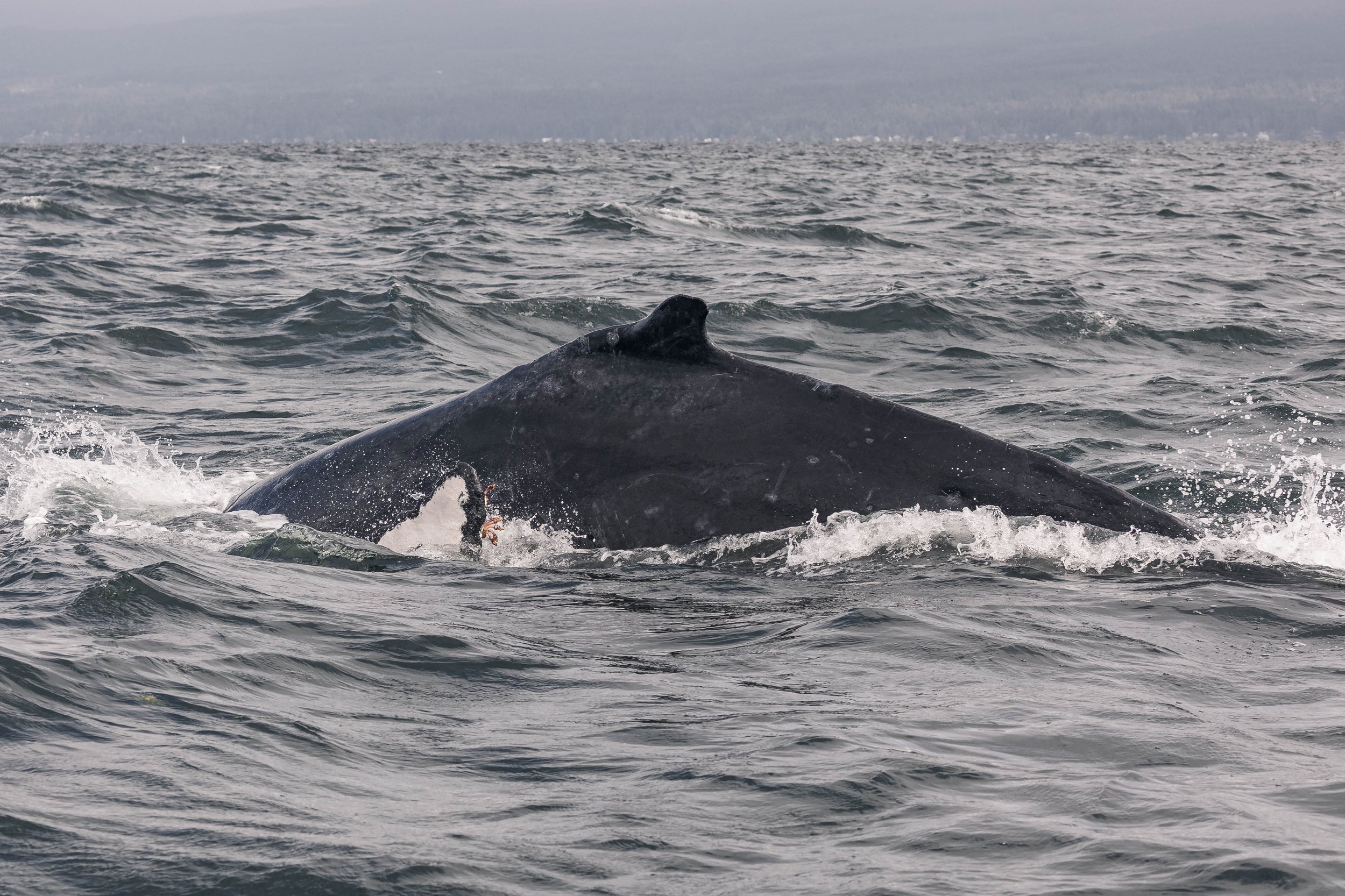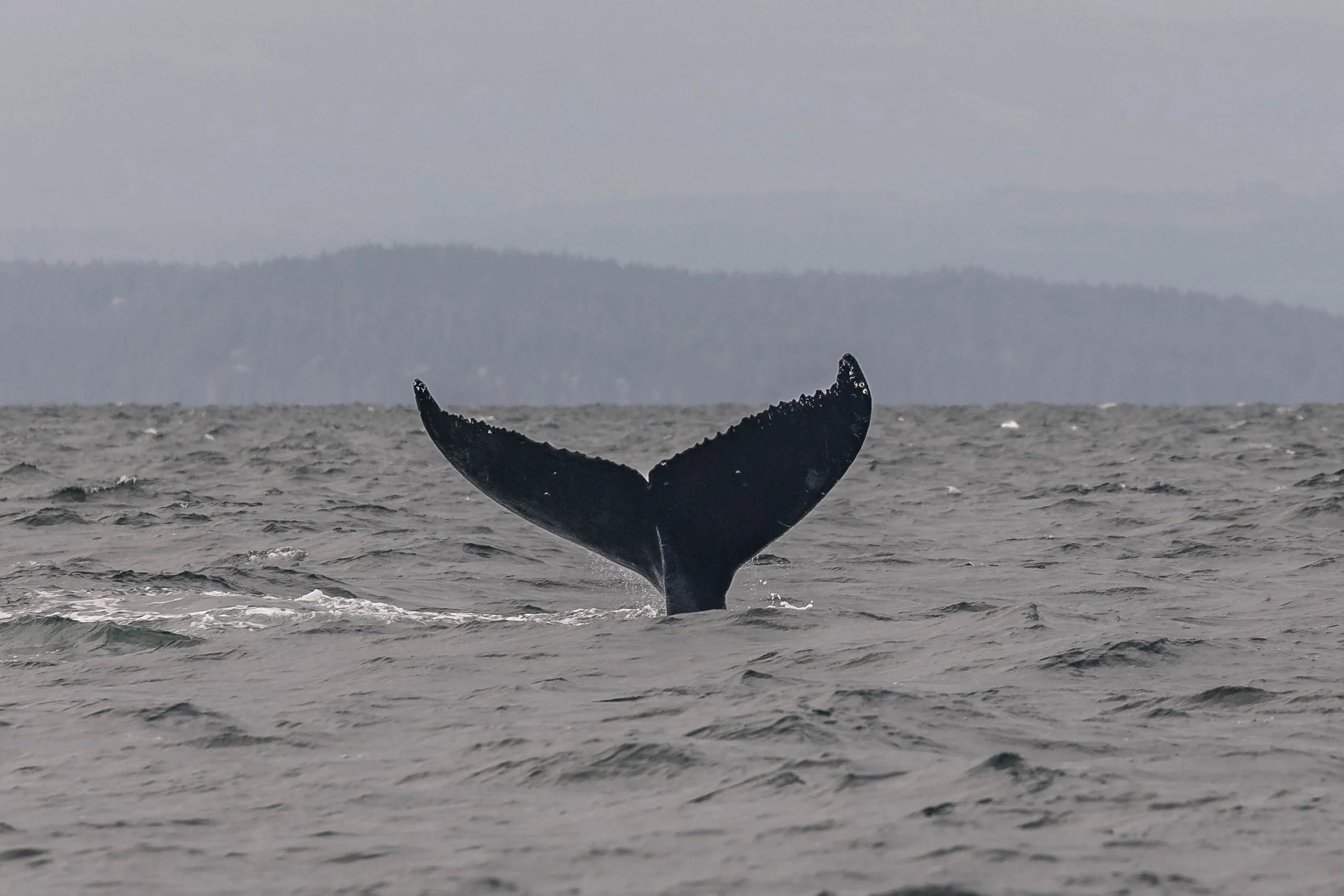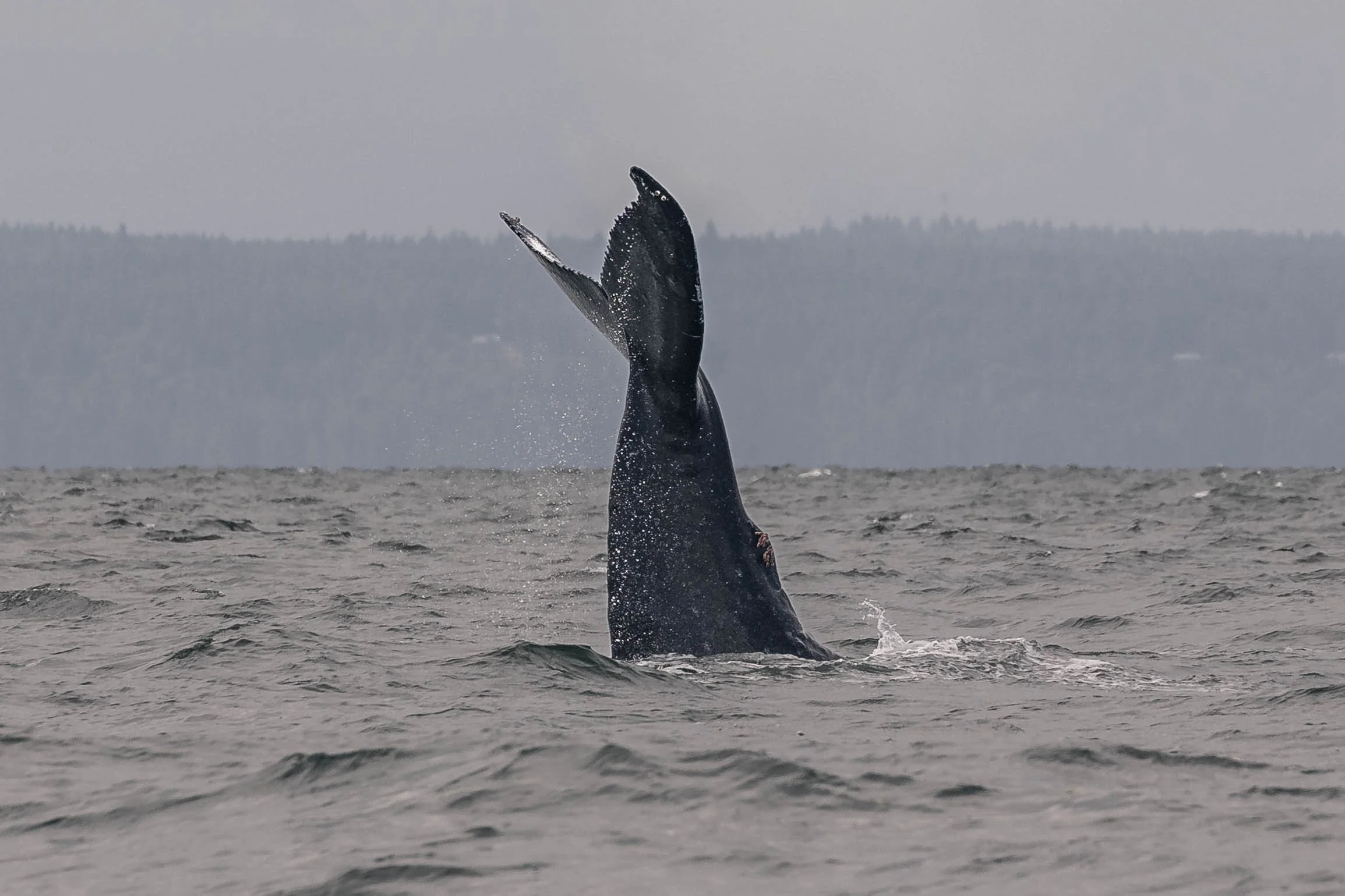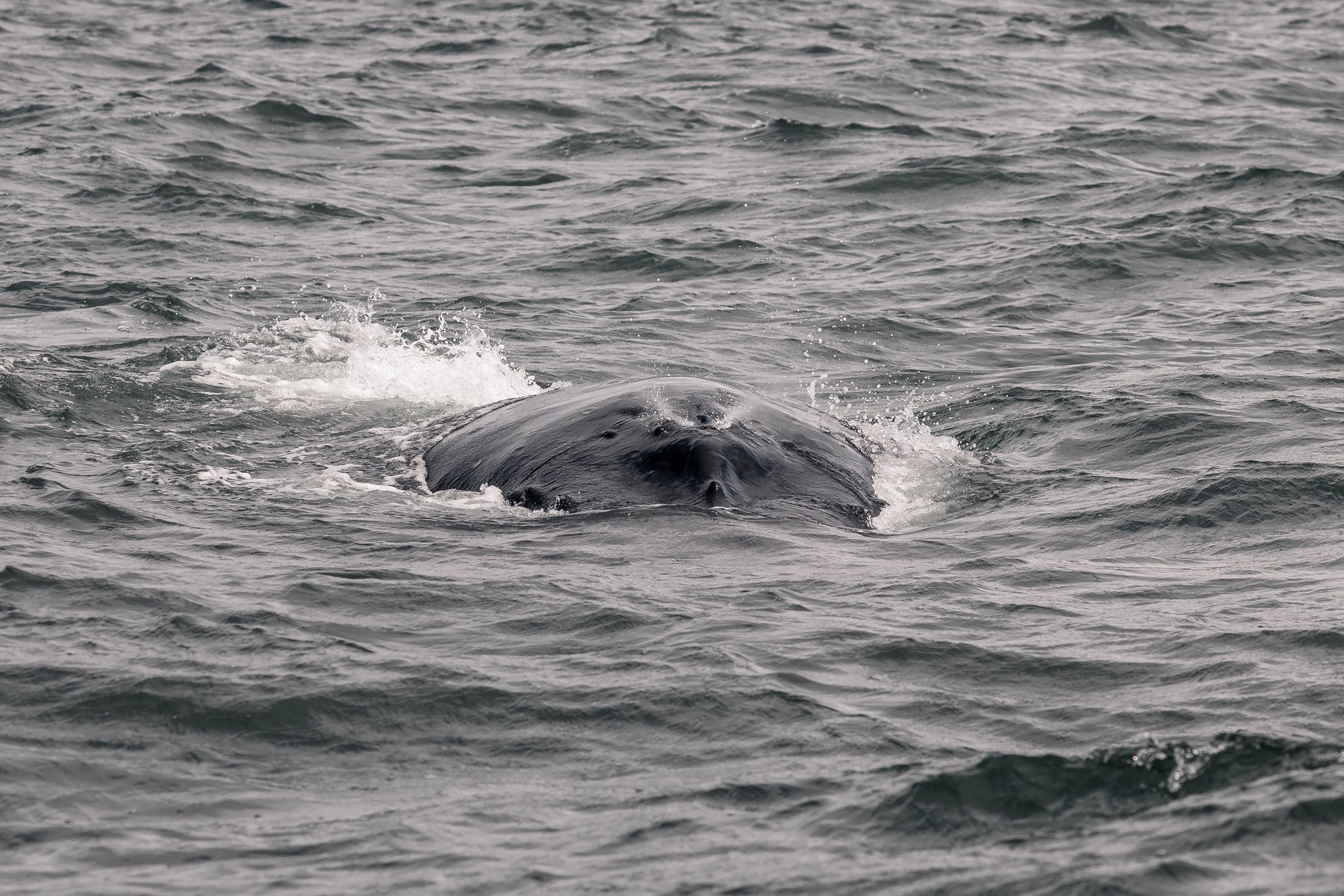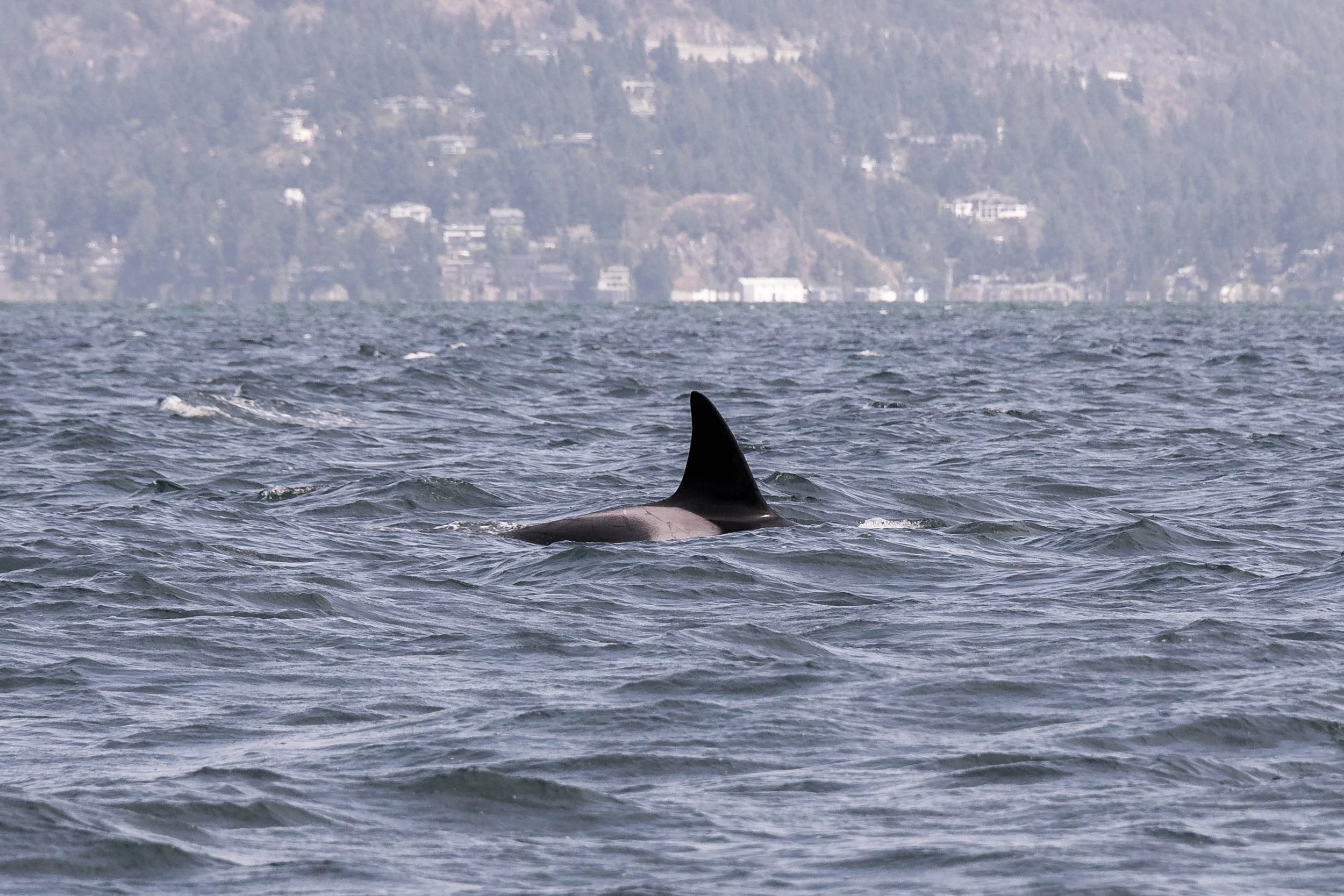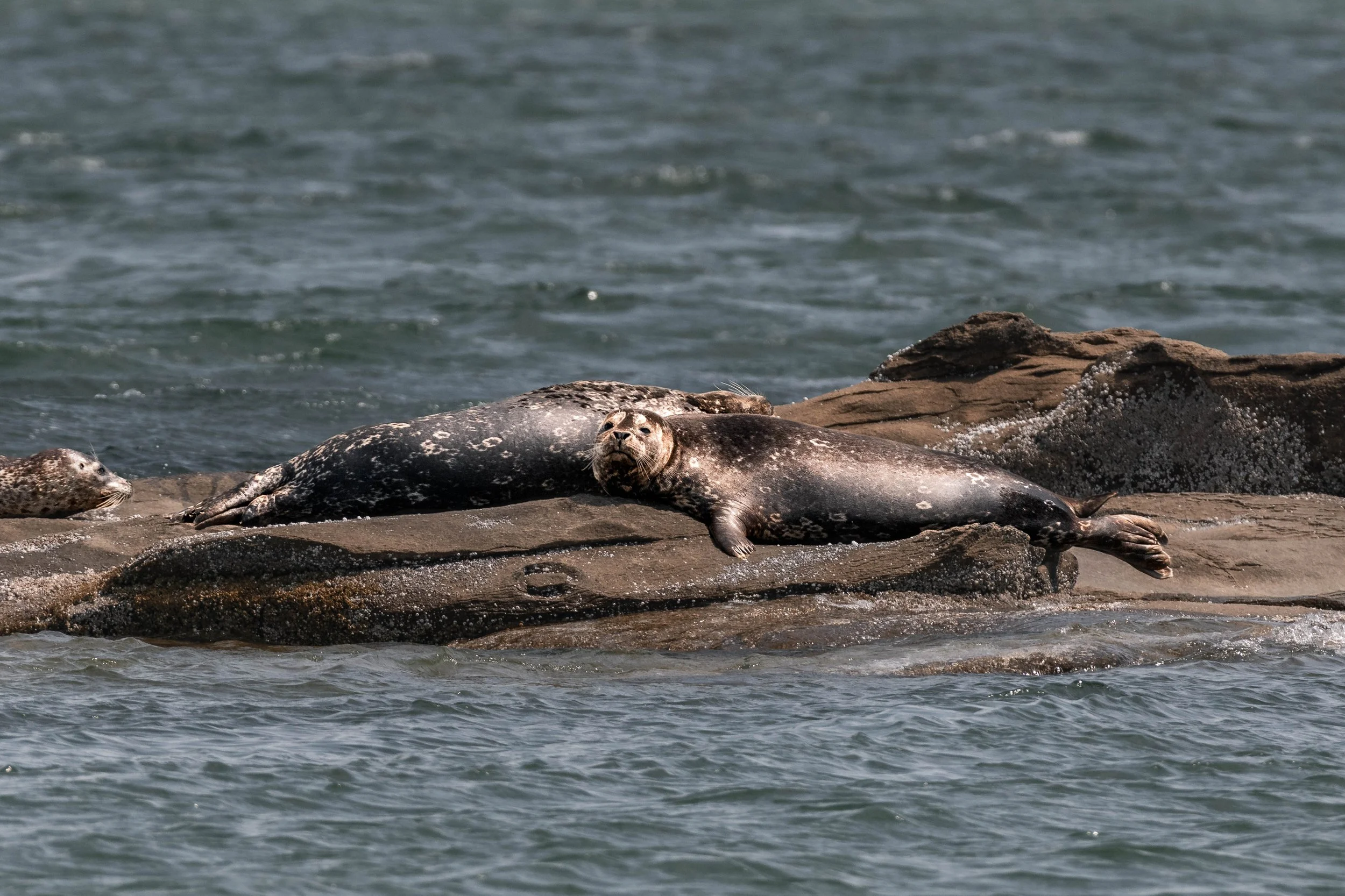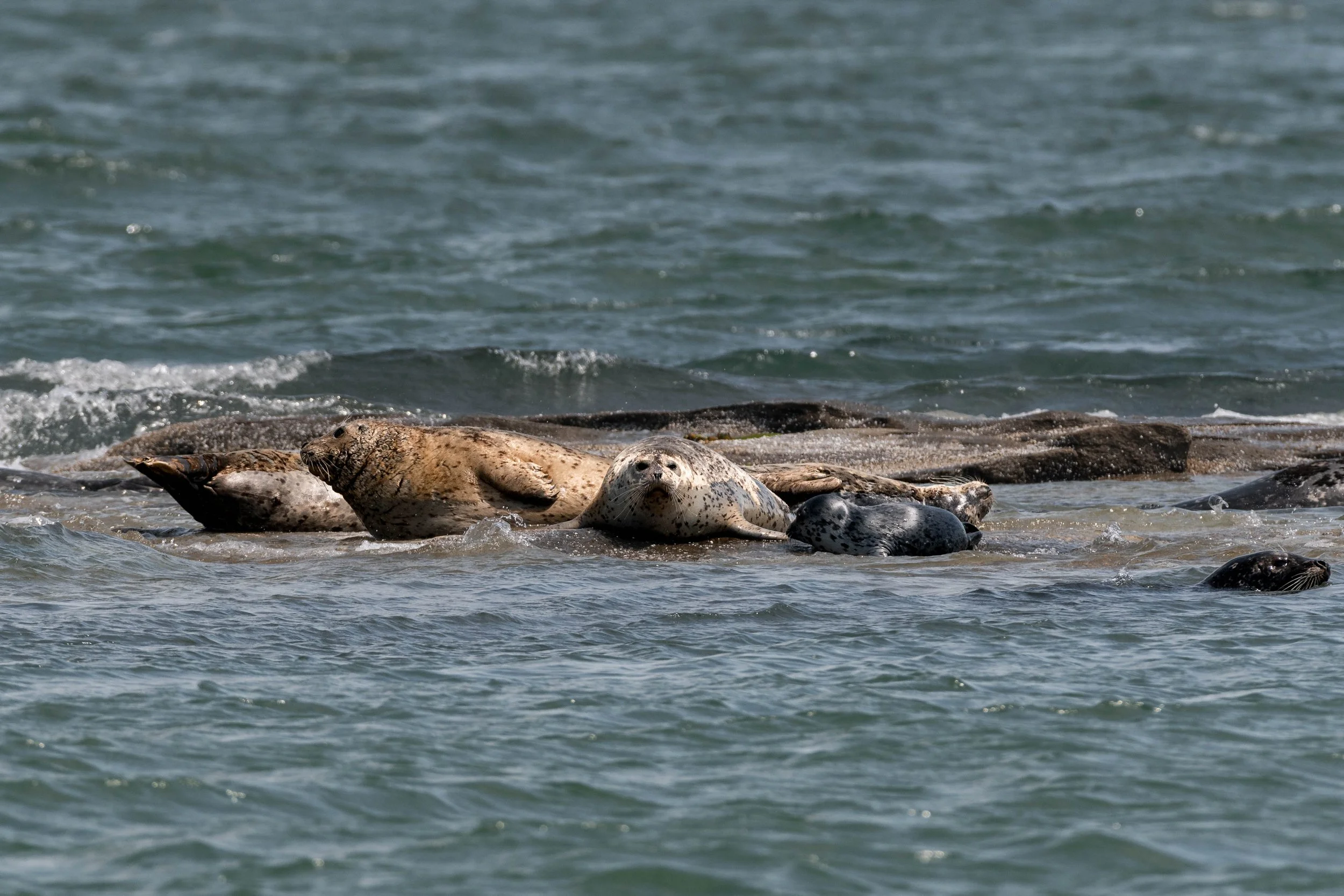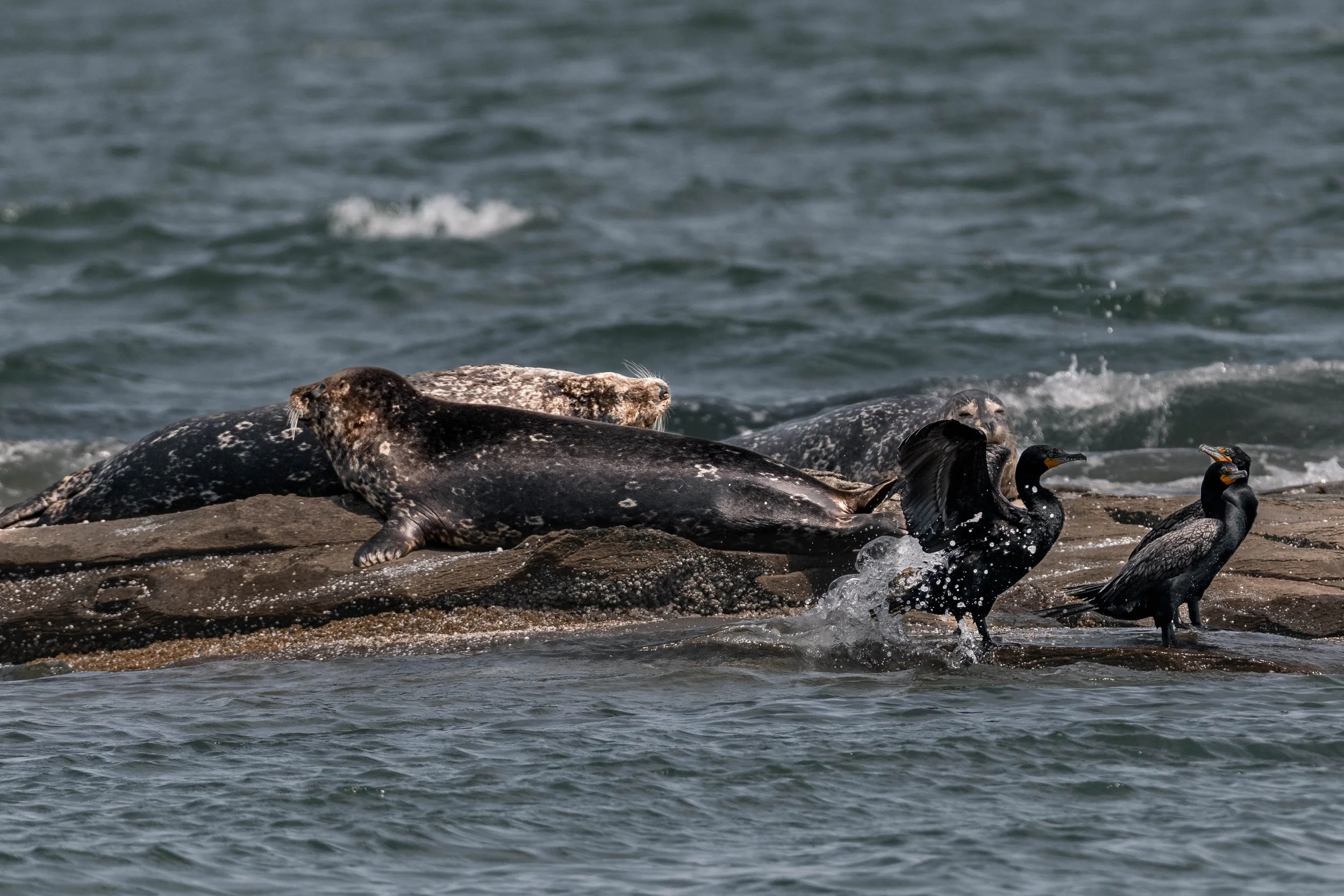July 19, 2025, 10:30 AM - A double creature feature in the SOG!
On this wavy morning, our full fleet left the dock! Vessels Keta, Cascadia, and Kula set off into the Strait of Georgia in search of some spectacular marine life. Upon reaching an area known as Halibut Bank, an underwater mountain of sorts, our vessels spotted some blows!
It appeared that two humpback whales were in the area feeding right off Halibut Bank, an underwater mountain of sorts. The peak of Halibut Bank reaches 42 meters (138 feet) and plunges to 200-300 meters (650-1000 feet). The slope of Halibut Bank is perfect for all types of marine life, especially for humpback whales that come to feed on Krill. Initially, these two humpbacks were not associating. Our vessels split up to identify both whales, and we found out that the humpbacks were none other than Grizzly (BCY1330) and Crackle (BCY1227). Our other boat had its own humpback encounter at this point as well, with Divot (BCX1057).
Humpback whales are highly migratory animals, spending their winters in warm tropical waters for breeding and returning to more temperate or polar regions, like the Salish Sea, during summer to feed. The two humpbacks we encountered today both migrate south to Hawaii for the winter and come back here to feed through the summer months. During this time, they consume an impressive amount of food, up to 3,000 pounds (or a ton and a half) each day! These humpbacks need to pack on the pounds before they return south, as humpbacks do not eat at all during their months-long migration and breeding period. In fact, they can go upwards of six months without feeding! Halibut Bank provides excellent foraging conditions for these whales, as they typically dive to depths of around 200 feet in search of prey, but are capable of diving as deep as 700 feet if necessary.
As time went on, Grizzly and Crackle came together for some synchronized diving and feeding. As our time with the humpbacks wrapped up, some exciting news had come over the radio. The captains got word of some Orcas just east of Halibut Bank! Our vessels braved the waves and made their way towards Vancouver. Upon arrival, the pod of orcas had been identified as the T137’s!
T137 Loon ♀ (~1984)
T137A Jack ♂ (2002)
T137B Tempest ♀ (2006)
T137D Wright ♀ (2012)
The pod swam close together, breaking through the waves as they surfaced. When identifying which orca pod we're observing, we rely on a few factors. First, we count the number of individuals in the group, taking note of how many have big dorsal fins (males) and how many have smaller ones (females or juvenile males). This can help us narrow down the possibilities. Additionally, we also look closely at the dorsal fins for any unique nicks, notches, or scars. These unique markings act like fingerprints, allowing us to identify the individual orca first. Since orcas usually stay with their family pod for life, identifying one whale often tells us which pod the whole group belongs to! When observing the T137’s, a majority of the orcas in this pod have identifiable notches on their dorsal fins. Jack (T137A) has a large male dorsal fin that has two notches (one in the middle, one above the base), whereas Loon (T137) and Wright (T137D) each have one notch in different positions on their small dorsal fins.
Our Zodiac boats spent some quality time with the orcas, as our semi-enclosed vessel headed off to find some seals and sea lions. Kula, our semi-enclosed boat, had found itself at a rocky outcrop off the outer shore of Valdes Island, dubbed “Stinky Rocks” by those who visit. Those unfortunate enough to be downwind of the Sea lions stationed there get to find out why the rock has this nickname! Since there are so many animals eating, sleeping, feeding, and defecating together on one small rock, the smell is as bad as you imagine it to be!
The Steller Sea Lions that haul out there are the largest species of sea lion in the world! Female Steller Sea Lions only grow to be one-third the size of mature males, with males reaching 11 feet long and weighing upwards of 2500 pounds, whereas females max out at around 800 pounds and reach 8 feet long. When males and females of a species have distinct physical differences, the species is said to exhibit sexual dimorphism. The size difference is a crucial advantage for the males during the breeding season, which runs from late May to mid-July. These large dominant males must claim and defend their harem of females from other large competing males. Once a male has secured his harem, he will stay on land and defend his group from other males for the rest of the breeding season, meaning that he won’t get the opportunity to feed for upwards of 2 months! But this fast is essential for the dominant male to secure reproductive success.
As our Zodiac boats wrapped up with the T137’s, they made their way back across the Strait of Georgia. Vessel Cascadia headed over to Stinky Rock to enjoy the company of the Sea Lions while vessel Keta made their way back towards Nanaimo. Going with the waves, Keta found themselves at Snake Island. This island hosts some Harbour seals, which take advantage of the rocks exposed at low tide. Additionally, our vessel spotted lots of little birds blending in with the rocks. Upon further inspection, the birds were identified to be Black Turnstones!
These seals only weigh up to 280 pounds and grow to be 6 feet long. Males and females are pretty indistinguishable from each other, unlike sea lions. The snout of harbour seals is shorter and more blunt when compared to that of sea lions. These cute little pinnipeds are considered true seals because they belong to a different evolutionary lineage compared to sea lions. One of the key differences lies in their anatomy: true seals lack external ear flaps (pinnae) and have smaller front flippers. Additionally, their pelvic bones are fused, which limits their ability to move on land, but it gives them a powerful advantage in the water. This adaptation enhances thrust and agility, crucial when evading their primary predator: the killer whale. It is also pup season, and we saw several cute baby faces amongst the adults!
After their company with the seals, our vessels headed to the bluffs of Gabriola Island. The rocky cliffs of Gabriola Island have very unique holes and pockets in the sandstone. As the sandstone rock wears down, it creates the perfect nesting spot for cliff-nesting birds such as Cormorants, Pigeon Guillemots and Cliff Sparrows. A majority of the birds viewed on the rocky bluffs are Double-Crested Cormorants and Pelagic Cormorants, which build their nests out of twigs, driftwood and seaweed. It was a great end to this wildlife-filled day!
Enjoy the photos below by Aly Kohlman, Vanessa Vereschahen and Jordan Robinson.
Divot (BCX1057) going for a dive. Photo by Aly Kohlman.
Crackle (BCY1227) going for a dive. Photo by Jordan Robinson.
Grizzly’s (BCY1330) tail fluke. Photo by Vanessa Vereschahen.
The dorsal (top) side of Crackle’s (BCY1227) tail fluke. Photo by Jordan Robinson.
The ventral (underside) of Crackle’s (BCY1227) tail fluke. Photo by Jordan Robinson.
Crackle (BCY1227) going for a big fluke slap! Photo by Jordan Robinson.
Crackle (BCY1227) upside down! Photo by Jordan Robinson.
Crackle (BCY1227) making a splash. Photo by Jordan Robinson.
Crackle’s (BCY1227) upside down with thier pectoral fins up in the air. Photo by Jordan Robinson.
Big blow from Crackle (BCY1227). Photo by Jordan Robinson.
Crackle (BCY1227) surfacing. Photo by Jordan Robinson.
Crackle (BCY1227. Photo by Jordan Robinson.
Crackle (BCY1227) goiing for a deep dive. Photo by Jordan Robinson.
Crackle (BCY1227) giving us a spy-hop! Photo by Jordan Robinson.
Steller Sea Lions on the ODAS buoy at Halibut Bank. Photo by Vanessa Vereschahen.
T137B Tempest’ s dorsal fin. Photo by Vanessa Vereschahen.
T137A Jack coming up for a breath. Photo by Vanessa Vereschahen.
T137A Jack behind his mom T137 Loon. Photo by Vanessa Vereschahen.
T137B Tempest with Vancouver in the background. Photo by Vanessa Vereschahen.
T137B Tempest swimming along. Photo by Vanessa Vereschahen.
The pod’s matriarch T137 Loon (front) with her son T137A Jack. Photo by Jordan Robinson.
The very tip of T137A Jack’s dorsal fin with his little sister, T137D Wright, beside him. T137B Tempest taking lead. Photo by Jordan Robinson.
T137’s Jack with T137 Loon. Photo by Jordan Robinson.
T137A Jack with his little sister T137D Wright. Photo by Jordan Robinson.
T137 Wright (Front), T137B Tempest (Middle), and T137A Jack (back). Photo by Jordan Robinson.
T137B Tempest (Front), and T137A Jack (back). Photo by Jordan Robinson.
A large male Stellar Sea Lion. Photo by Vanessa Vereschahen.
A pile of Sea Lions. Photo by Vanessa Vereschahen.
Talkin’ things out! Photo by Vanessa Vereschahen.
Harbour seals enjoying the sun. Photo by Aly Kohlman.
Notice the small little baby Harbour Seal! Photo by Aly Kohlman.
Seals with some Double-crested Cormorants. Photo by Aly Kohlman.
Takeoff! Photo by Vanessa Vereschahen.
Black Oystercathcers on Snake Island. Photo by Jordan Robinson.
Black Turnstones and Surf Birds on Snake Island. Photo by Jordan Robinson.
A Double-crested Cormorant perched on Gabriola Island. Photo by Jordan Robinson.
Passengers aboard Kula. Photo by Vanessa Vereschahen.


